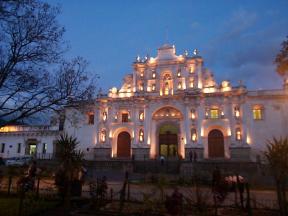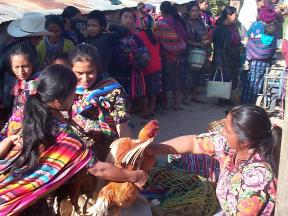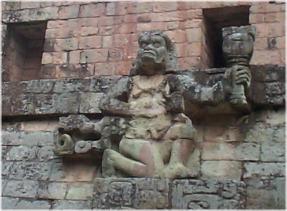|
Only an hour outside the grimy sprawl of Guatemala City is the historic capital of Antigua. This is a small, low-rise city of ruined cathedrals each seemingly more spectacular than the next. After wandering around for awhile, you start to get a bit numb to the sight of these ruins: "Oh, look over there, another spectacular ruined church." It doesn't take long to get an appreciation for the power of earthquakes as you stand before huge slabs of stone that fell from once lofty heights above spectacular columns.
 |
|
Antinguan
square at dusk
|
The wealth that built these colonial churches is still present in Antigua, although the high walls that ring the private compounds make it difficult to witness. Fortunately, some of the grand homes have been converted into hotels and restaurants. Just a few steps through an austere wall and you leave the cobbled streets to find an oasis of beautiful Spanish architecture, fountains and well-tended gardens.
Lake Atitlan, about four hours by tourist bus from Antigua, is a famed resort area in a volcanic valley. The main resort town of Panajachel is a tacky jumble of hotels, restaurants and souvenir stalls that can rival any overdeveloped beach town. The beach is little more than a thin gravely strip, but the view is spectacular. A well-tended footpath on the west side of the lake offers some of the best views, and allows you to share the trail with Mayans in traditional dress as they pass by on their way from one village to the next. The views are also great from the ferries that regularly cross the lake. The boat to Santiago Atitlan takes you to a stunning inlet between the volcanoes.
The lakeside villages are simple and unimpressive, but the population is beautiful. Women almost universally wear traditional clothing, which features ornately embroidered huipile blouses. Their conservative dress, thin frames, and long dark hair offer great contrast with Guatemalan immigrants in the United States, who often adopt the least aesthetic elements of western culture.
 |
|
Buying
a chicken in Chichicastenango
|
This traditional dress is also present in the popular market town of Chichicastenango, which offers a sprawling collection of stalls that spills out of the main square every Thursday to the delight of visitors. About half of this is tourist-oriented, but there is enough local color to keep it from getting stale. Poultry is sold by little boys carrying live turkeys by their feet. Pig markets and produce stands dot the town, and carved masks and woven blankets are available at great prices if you bargain.
An easy side trip from the highlands can be found just over the border in Honduras. Here, the ancient Mayan ruins of Copan offer the most impressive detailed rock carvings from the the pre-Columbian world. The pretty little modern town of Copan Ruinas is just a mile to the west, and is a great place to stay and relax after a day at the ruins.
 |
|
Detail
at Copan
|
Guatemala city, the capital, is an interesting mix of American-style suburbia on the outskirts, with strip shopping centers and mini-marts bordering shantytowns that cling to the edges of ravines. The city center is almost universally dismal, with run-down but well-used buildings surrounding a tiny touristed area that can't even seem to envelop the entire main square. The main cathedral is worth a peek, and the depression-era national palace is a telling example of the misappropriation of weath in a dictatorship.
David G. Young and James M. Campbell toured Guatemala and Honduras over Thanksgiving week 2001.
See the complete set of photos from this trip.

